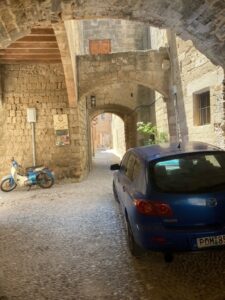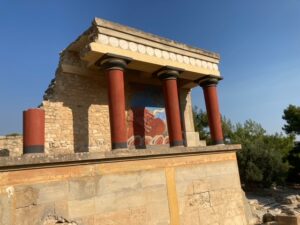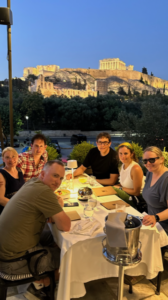This month my friends and I visited Greece–instead of a mainland journey as I’ve previously taken, we took an odyssey to the islands. As it turns out, our voyage was in the midst of a heat wave that has since resulted in dangerous wildfires–we missed this calamity by mere days, and I wish everyone there safety and a swift recovery.
We began with a journey to Mykonos, gem of the Cyclades. A warren of narrow alleys thread whitewashed buildings, where each twist and turn brings the traveler to a different shop or taverna. The sea is liquid sapphire–a blue so rich it makes the heart ache. Mykonos is the Greek flag brought to three-dimensional life, and at night it transforms into a shimmering constellation of humanity. There’s also an astonishing number of cats prowling the streets, and some of these structures look like they’ve been transplanted from Tatooine.
Not far away sits the isle of Delos, once the seat of the mighty Delian League where a people’s destiny was debated in the wake of the Persian Wars.
As the ancient Greek writer Alcaeus once wrote: “Now is the moment, now, to take what happiness the gods allow”.
#
From Mykonos and its absurdly amazing seafood, we visited Turkey, from the coastal city of Kusadasi to the awe-inspiring ruins of Ephesus and the Library of Celsus.
Ephesus is an archaeological site for the ages–the best I’ve seen yet. A sprawling agora that was once the major artery of Roman life: fountains, bathhouses, public toilets, temples, shops, and mosaic-lined floors of startling beauty. But the showstopper is the library–it brought tears to my eyes. The Library of Celsus was the third largest in the Roman world, with more than 12,000 books, and was built to honor former proconsul Tiberius Julius Celsus Polemaeanus… who was actually buried beneath it! This is the closest we’ll ever see to the Great Library of Alexandria, which was likely built along similar architectural lines. The Library of Celsus was later destroyed by a combination of earthquake and Gothic invasions. Dammit.
This is the greatest archaeological site I’ve yet seen. You can practically see ancient lives passing by you on these forgotten roads.
Afterwards, my friends and I went to Patmos. The island is nearly split asunder by blue bays. Home to imposing medieval fortresses and monasteries of grey-white stone, there’s an austerity here befitting its religious history, at odds with the more colorful locales around the Dodecanese and Cyclades.
#
Rhodes, once home of the Colossus–another of the Seven Wonders of the World.
In 305 BCE, the island was invaded. In addition to enemy soldiers, the invasion included a staggeringly massive siege tower: iron-skinned, with eight wheels and loaded with catapults and archers. Despite the terror this machine must have caused, it wasn’t enough to breach the city’s walls. When the enemy fled the island in defeat, the siege tower was melted down and turned into a mighty statue of Helios that–millennia later–would inspire the design of the Statue of Liberty.
What I found especially interesting was that Rhodes is a medieval city that’s still inhabited. Within crenelated walls are cars and motorcycles.
#
Following the colossally interesting island of Rhodes, we went to Crete, land of the Minotaur and seat of the mighty Minoan civilization. The ruins at Knossos were ancient even by Greek standards, and have excited my imagination since childhood. To actually be here, witnessing these pillars in the palace complex, with extant pottery and vibrant frescoes, is breathtaking. This maritime empire was felled when the volcano on nearby Santorini exploded around 1400 BCE.
Since then, Crete has had a motley history. It’s been conquered by Romans, pirates, Venetians, Arabs, Byzantines, and during WW2 was the site of one of the largest paradrops ever: 15,000 Nazi paratroopers floating down to take the island.
#
Our penultimate stop was the island of Santorini, the beautiful aftermath of volcanic fury.
The bewitching colors around the caldera are like a geological photograph of that fateful day thirty-four-hundred years ago. Lava red, smoldering orange, and glowing yellows display an autumnal tableau–eerily appropriate, considering that this eruption heralded the fall of Minoan civilization. By sunset, more colors emerge in a sedimentary rainbow.
And Poseidon’s wrath hasn’t abated even today. Eruptions still occur, raising small sulphuric islets that–legend has it–are home to vampiric wraiths. As lovely as Santorini is, it’s easy to feel a somber and dark fascination; I’m acutely aware that I’m visiting here in the sliver of time before the next cataclysm. These photos are moments captured in digital amber.
On a less somber note, the food here is sumptuous, the wine plentiful, the locals full of life and cheer, and my traveling companions are wonderful humans.
#
We completed our journey in Athens, the birthplace of democracy. It was 105 degrees even at 8 p.m., so we were rubbing ice on ourselves to keep from incinerating, but every moment of our final dinner was lovely –I had black orzo with cuttlefish ink and seafood–and check out this view.
“Someone, I tell you, in another time will remember us”
–Sappho












